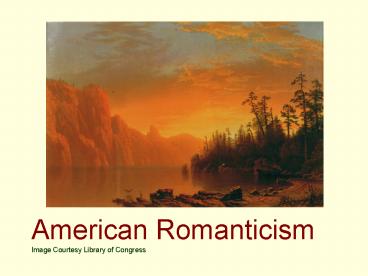American Romanticism Image Courtesy Library of Congress - PowerPoint PPT Presentation
1 / 10
Title:
American Romanticism Image Courtesy Library of Congress
Description:
A deep love of nature, a source of wisdom, guidance, consolation, and happiness ... and habits of the North American savage, taken in connection with the scenery ... – PowerPoint PPT presentation
Number of Views:89
Avg rating:3.0/5.0
Title: American Romanticism Image Courtesy Library of Congress
1
American RomanticismImage Courtesy Library of
Congress
2
Key Figures
- Washington Irving (1783-1859)
- James Fenimore Cooper (1789-1851)
- Ralph Waldo Emerson (18031882)
- Margaret Fuller (1810-1850)
- Henry David Thoreau (18171862)
- Edgar Allan Poe (18091849)
- Nathaniel Hawthorne (18041864)
- Herman Melville (18191891)
3
Key Dates
- 1786 Publication of Freneaus The Wild Honey
Suckle - 1791 Publication of Bartrams Travels
- 182060 Peak of American Romanticism
- 1817 Bryants Thanatopsis
- 1819 Irvings Rip Van Winkle
- 1820 Irvings Sleepy Hollow
- 1823 Coopers Pioneers
- 1845 Fullers Woman in the Nineteenth Century
- 1850 Hawthornes The Scarlet Letter
- Emersons Representative Men
- 1851 Melvilles Moby-Dick
- 1854 Thoreaus Walden
- 1855 Whitmans Leaves of Grass
- 1861 With the Civil War, the Romantic movement
and its optimistic spirit ended
4
Key Facts about the Period
- There are three principal reasons for the
development of American Romanticism - The breakup of New England Calvinist sects and
the emergence of Unitarianism as a compromise
between Calvinism and Deism. - The influence of French, British, and German
Romanticism Rousseau, Wordsworth, Carlyle,
Scott, Shelley, Keats, Herder, Kant, and Goethe. - The rise of political nationalism, which fueled a
cultural nationalism.
5
Key Facts about American Romanticism
- Characteristics
- A sense of wonder
- Belief in the potentiality of all life
- Adherence to the view of individuals as innately
good - Faith in the directing resource of the
subconscious, inner life - The favoring of the emotions, intuition, and
imagination over intellect, science, and
rationalism
6
Key Facts about American Romanticism
- Anti-intellectual
- Books are for the scholars idle times. When he
can read God directly in nature, the hour is
too precious to be wasted in other mens
transcripts of their readings. - Emerson, The American Scholar
- A deep love of nature, a source of wisdom,
guidance, consolation, and happiness (Consider
the Hudson River School of Painting.) - Healthy contempt for traditions, conventions, and
past knowledge, all of which can be restrictive
of new, individualistic approaches to life - The books of an older period will not fit this.
Meek young men grow up in libraries, believing it
their duty to accept the views, which Cicero,
which Locke, which Bacon, have given, forgetful
that Cicero, Locke, and Bacon were only young men
in libraries, when they wrote these books. - Emerson, The American Scholar
7
Key Facts about American Romanticism
- Anti-authoritarianism and anti-institutionalism,
celebrating those most remote from civilizations
corrupting influences, such as Indians and
children - There is something in the character and habits
of the North American savage, taken in connection
with the scenery over which he is accustomed to
range, its vast lakes, boundless forests,
majestic rivers and trackless plains, that is, to
my mind, wonderfully striking and sublime. - Washington Irving, Traits of Indian
Character - Intense nationalism, often calling for the
development and support of a native literature
8
Key Facts about American Romanticism
- Search for more organic forms to compliment the
new country - Works of adventurous literature (sometimes
boyishly so), with stories of life among
cannibals, Gothic horror tales, Indian fights,
and struggles out West - For some, an interest in the Gothic, the
mysterious, the strange (Hawthorne and Poe) - Often symbolic (Hawthorne, Melville, and Poe)
- Often treat of openly personal, subjective, and
autobiographical themes - I celebrate myself, and sing myself,
- And what I assume you shall assume,
- For every atom belonging to me as good belongs to
you. - I loafe and invite my soul
- I harbor for good or bad, I permit to speak at
every hazard, - Nature without check with original energy.
- Walt Whitman, Song of Myself
9
Key Facts about American Romanticism
- An admiration for reformers and individuals of
action, like John Brown (a hero to Thoreau,
Melville, and Emerson) - Often involved in social movements, like
abolition and womens rights. - Activism often took precedence over writing
- My life has been the poem I would have writ
- But I could not both live and utter it.
- Henry David Thoreau
10
Reading
- See The American Tradition in Literature 11e
- Read The Romantic Temper and the House Divided
(pp. 293-98) and Romanticism (pp. 122122). - Look through the Chronology (pp. 56162).
- Read the head notes and works by Emerson, Fuller,
Thoreau, Poe, Hawthorne, and Melville (as
directed by your instructor).































